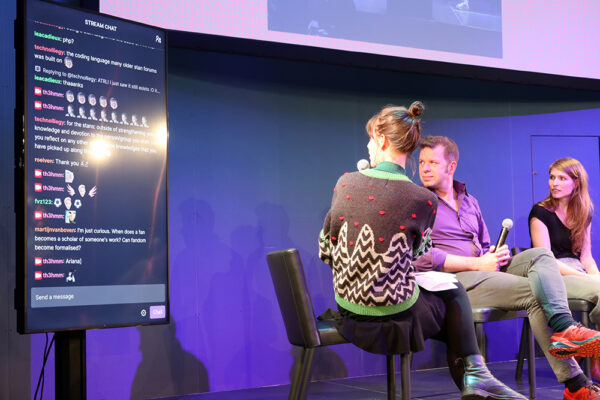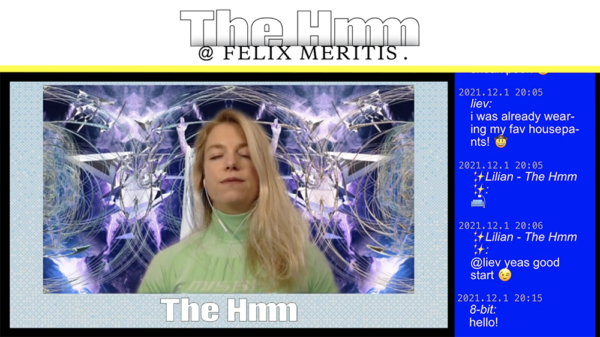We believe that simply streaming your event does not make the best hybrid experience. Our aim is that the experience of the virtual audience is not inferior to the experience of the physical audience. How? We don’t know yet, but we’re definitely trying to find out. There is so much to learn about creating meaningful and vivacious hybrid experiences. For example: How do we connect a physical and virtual audience? Should the experience be the same for virtual and physical visitors? How can we give online visitors a sense of place? Since the fall of 2021 we’ve been actively experimenting with hybrid events as we delve even deeper into the internet cultures that shape, complicate, and transform our lives—further blurring the boundaries between the ‘online’ and ‘offline’ worlds.
Below we list the formats we’ve tried out, what we’ve learned from each experiment, and how visitors experienced it.

inti-mate – A buddy system
The experiment: The Hmm @ Real Feelings, a Hmm fast event with eight speakers, physically took place in the exhibition Real Feelings at MU in Eindhoven. MU was also our collaboration partner for the design and implementation of the experiment. Every online visitor was linked, via their phone, to a visitor who was physically present in the exhibition space. To start off the evening program, the physical guests guided their online buddy around the Real Feelings exhibition and brought them into contact with other visitors. During the presentations, which the online visitors were following via our livestream website, the online audience could only ask questions to the moderator via their physical host. Basically, each physical visitor was ‘hosting’ one of the online visitors—creating a more intimate one-to-one experience. We offered all kinds of experimental devices and prototypes to mount a phone in order to ‘host’ a virtual buddy hands-free.
A comment from a visitor: I experienced the evening extra alertly and extra intensely because I had a great time showing my buddy around the exhibition and chatting with them all evening. It was really kind of magical, perhaps even enough to allow me to connect with full attention during the event, being ‘in the moment’ together.
Something that went well: As organisers, we didn’t feel that there was a big difference between the online and the offline speakers. When working with hybrid formats we felt that the online speakers might be seen as secondary to the ones that are there in person, but in our experience the audience was just as engaged with the speakers who were joining us remotely as they were with the speakers that were physically present.
Something that went wrong: We experienced technical issues with sound. We learned that with hybrid events there are a lot of different audio inputs and outputs coming from different sources simultaneously. It is very important to test all the configurations in advance for the different scenarios and to also be prepared to trouble-shoot and solve technical issues on the spot, as well as having backup plans just in case.

Visitor says: YasBirb – Embracing the chat
The experiment: During The Hmm ON Online Fandom, that physically took place at Felix Meritis in Amsterdam, we wanted to explore the power of the chat. Instead of streaming on our own platform, we used Twitch for this event because of the playful chat interactions this platform offers. To literally give the online audience a place in the room, we placed two screens on stage showing the chat live. The physical audience could see the conversations happening in the chat and they were also welcome to join the chat. We added custom emotes to our Twitch channel, related to the topic of the event. The emotes that people sent popped up on, and floated across, the livestream. As always, we also had a chat moderator who was overseeing the livestream chat on Twitch.
A comment from a visitor: Because you can have a question without interrupting the main talk, it feels like both standing at the bar and having a front row seat at once.
Something that went well: The chat was really active, and was experienced as ‘fun’ by our audience. In our feedback form one visitor said that seeing their messages appear in the chat that was visible on stage made them feel important. Because the emotes appeared on the livestream, the audience got the opportunity to give very direct feedback to what was being said.
Something that went wrong: There could have been more interaction between the physical and virtual audience, as the physical audience was not really participating in the chat. There could also have been more direct interaction with the chat, for example the moderator could start a conversation with the online audience active in the chat by addressing them directly through the camera. And several online visitors told us that they would have loved to see more of the full space and not only the stage.

Prepping – A warming up for online visitors
The experiment: When we visit a physical event, we get dressed up, maybe grab a drink, and travel somewhere. This automatically ensures a certain form of dedication to the event and a clear separation from other things happening in the day. These pre-event rituals have gone missing in the process of organising online events. To visit an online event, you just have to open your laptop or turn on your computer. We usually have several tabs open and see e-mails popping-up, creating a situation where we often do other things in parallel to following the event. During The Hmm ON Screen New Deal we invited artist Annika Kappner to prepare our online audience for this program—linking us together between the digital and the analogue worlds.
A comment from a visitor: I appreciated the introduction as a break between the rest of my day and the stream of information and inspiration that was about to come with the 2 great speakers.
Something that went well: It created a focus for our event. During the event, serious and very politically dense topics were discussed. The meditation was a nice counterpart for it. By reminding people to declutter their digital environment and give attention to their body and the space from where they were watching the event, the audience could locate themselves and focus on our program. And the fact that all viewers participated in the meditation brought them together. They were commenting about their experience in the chat.
Something that went wrong: Because of new COVID-19 measures, we couldn’t do this event in a hybrid form but had to do it fully online, so it was difficult to get a sense of how this could have worked in a hybrid format. The advantage was that everybody could experience the guided meditation. Some visitors also noted that because they had had long days, the guided meditation put them into an almost ‘too relaxed’ state and it was difficult to fully follow the talks. We also had the intention to remind the audience of the meditation again during the break, but because of time delays with the presentations we decided to get rid of the break.